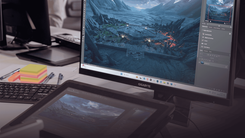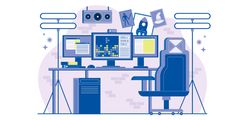Table of Contents
- The Challenges of Game Co-Development
- Core Communication Strategies
- Have Clear Communication Channels
- Kick-off Meetings
- Document Everything
- Tracking Tasks and Regular Talks
- Our Recommended Tools
- Final Thoughts
Communication Strategies in Codev
We take a look at how clear communication is key to successful game co-development between studios. We share practical and tested strategies and tools to help teams stay aligned, efficient, and collaborative across different time zones and workflows.
Co-development isn’t a new strategy in game development but it is becoming a more adopted strategy as studios look for more sustainable and cost effective ways to create video games.
Co-development is when multiple different studios or teams work together on a single game. Each brings its own expertise to the project, sometimes working on a major portion of the game, and other times handling smaller but equally important tasks. This approach allows studios to share the workload and bring in specialists for specific areas of development.
Not all co-development studios offer the same services. Some offer full services, or certain specific expertise such as 3D art, engineering, coding, concept art, game UI/UX design, and more. The partnership depends entirely on what the lead studio needs.
When managed well, co-development can create a smoother production cycle, saving both time and budget by spreading out the workload. However, success requires planning, coordination and - above all - strong communication.
In a global industry where teams often work across different time zones, cultures and workflows a solid communication is the foundation to a successful partnership. Without it even the most promising game projects can stumble.
In this blog, we’ll share proven communication strategies from our team here at Athena Productions, who have helped to provide needed services at quality, while relieving stress and making last longing relationships with studios.
The Challenges of Game Co-Development
When done correctly co-development can offer great benefits to teams. It gives studios access to specialized expertise and creative thinking without the time and cost of recruiting full-time hires.
It also helps companies spend their budgets more efficiently, scaling up or down depending on the needs of the project. If a certain skill set is no longer needed, the studio can then pause that service rather than carrying the cost of a permanent employee.
However, this flexibility can come with it's own challenges. If not addressed early, these issues can destabilize the partnership:
- Different pipelines and tools (e.g Unreal Engine vs Unity workflows)
- Cultural and language barriers
- Time zone differences that can slow feedback cycles
- Version control chaos when multiple studios touch the same assets
Core Communication Strategies
Have Clear Communication Channels
When beginning a new co-development partnership, you need to decide how and where communication will happen early on.
We recommend a mix of tools for different purposes:
- Slack/Microsoft Teams - daily, real-time discussions
- Jira/Trello - task and sprint management
- Confluence/Notion - documentation
- Miro/Milanote - whiteboards for reviews of images and art direction
Before choosing tools, define who on your team will communicate with the partner and what the aim is with the tools. Do you want them to be checking in daily? Participating in daily stands up? You also need to make sure everyone knows who has final approval and who can answer day-to-day questions.
It is also a good idea to clarify whether you want daily updates, every-other-day check-ins or weekly syncs. Regular stand-ups or face-to-face calls via video can go a long way in preventing miscommunication and building a long-term relationship with your partners.
You might even record briefing or feedback videos if that’s easier than writing out long notes. Setting core overlap hours for meetings across time zones also helps maintain rhythm and responsiveness.
A good co-development partner should ask these questions early, even before a contract is signed to make sure they understand how you like to work and communicate.
Kick-off Meetings
We always recommend starting with a kick-off meeting - ideally one focused on art direction, scope, and overall vision.
This will make sure everyone understands the project’s goals, style, and expectations from day one. A clear vision helps both internal and external teams get on the same page faster and produce consistent results right from the off.
Document Everything
Try to keep all design documents, build notes, and pipeline instructions updated and accessible throughout the engagement. A great place to have all of your documentation are centralized platforms like Confluence to make it easier for partners to find what they need without chasing or distracting your team for answers.
It might feel like you’re overloading your partner with information but too much documentation is far better than too little!
Tracking Tasks and Regular Talks
Regular communication isn’t just about progress tracking, it’s about building trust. Using shared dashboards such as Jira, Trello or Asana allows everyone to see task progress and deadlines in real time, keeping the entire production on track and clear.
For mid to long-term contracts, schedule regular video meetings in addition to written updates. Seeing faces and hearing voices helps to keep everyone on track, reduces the risk of misunderstandings and it can be a great way to build the relationship between two teams.
Your outsourcing partner should feel like an extension of your in-house team, not just a vendor behind a screen.
Our Recommended Tools
- Slack/Discord - real-time chat and quick updates
- Jira/Trello/Asana - project and sprint tracking
- Miro/MilaNote - virtual whiteboards that can be great to give feedback and art direct from
- Git/Perforce - code and asset synchronization
- Zoom/Microsoft Teams/Google Meet - live discussions and creative reviews

Final Thoughts
The cornerstone of any successful co-development partnership is clear, consistent communication.
Before beginning a project, take the time to build the right communication structure, one that supports teamwork, transparency and trust from the very start.
While tools can’t replace genuine partnerships, they can provide the framework that allows it to thrive. With the right communication systems in place, co-development can lead to lasting relationships and successful projects for years to come.
At Athena Productions, we’ve supported projects ranging from indie titles to AAA games. Our clients return to us regularly because of our strong communication, transparency, and dedication to delivering quality. If you’re looking for a reliable partner that can help you with your concept art and UI/UX design, get in touch today!



